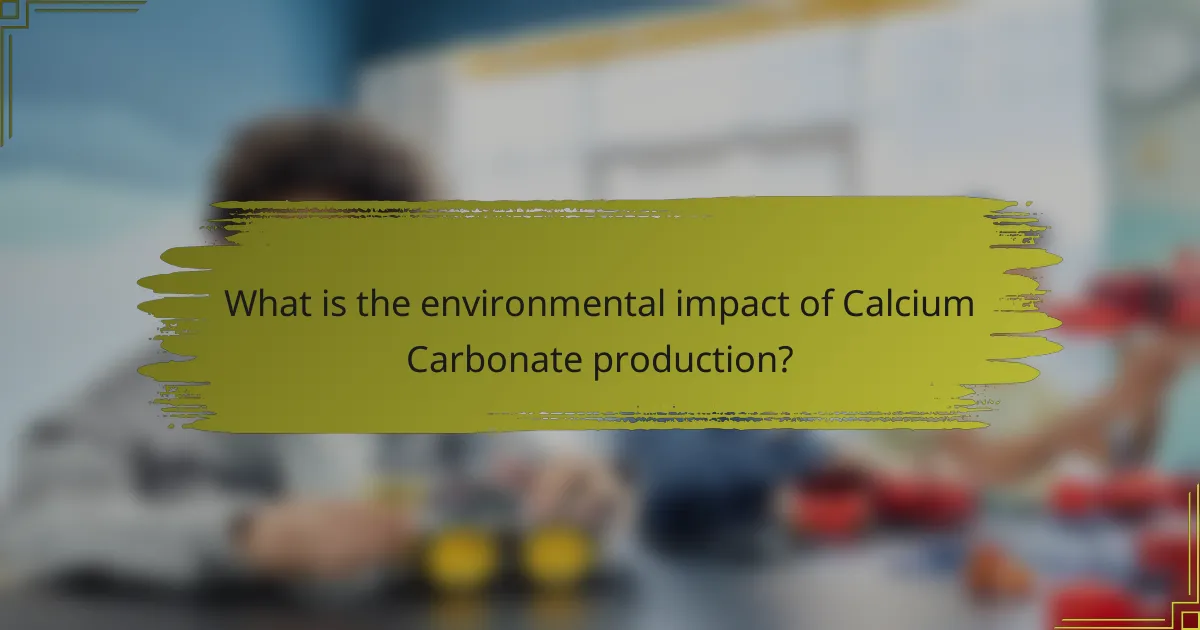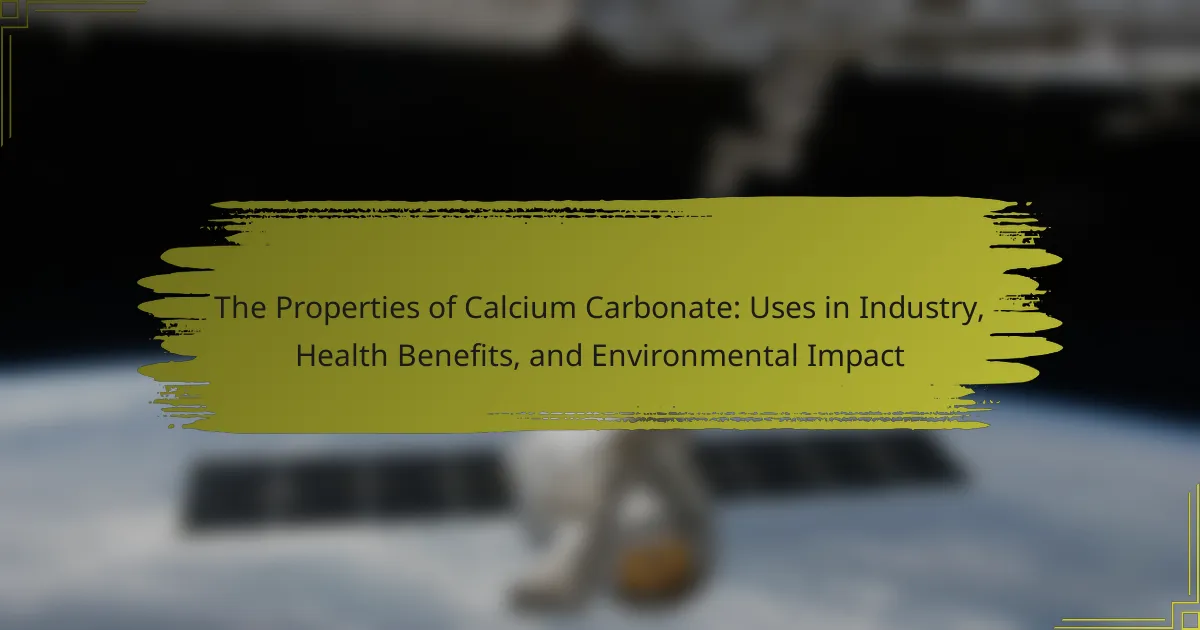
What is Calcium Carbonate?
Calcium carbonate is a chemical compound with the formula CaCO3. It is a white, odorless powder or crystalline solid. Calcium carbonate occurs naturally in rocks like limestone and marble. It is widely used in various industries, including construction and agriculture. The compound serves as a calcium supplement in health applications. Additionally, it acts as a filler in products like paints and plastics. Calcium carbonate also plays a role in environmental applications, such as water treatment. Its versatility is due to its abundant availability and low cost.
How is Calcium Carbonate formed?
Calcium carbonate is formed through natural processes, primarily via the precipitation of calcium ions and carbonate ions in water. This occurs in marine environments where organisms such as coral and shellfish extract calcium and carbonate from seawater. Over time, these organisms die and their shells accumulate, forming limestone, which is a sedimentary rock composed mainly of calcium carbonate. Additionally, calcium carbonate can also form through chemical reactions involving carbon dioxide and calcium hydroxide in industrial processes. This reaction produces calcium carbonate as a solid precipitate. The formation of calcium carbonate is a key component of the carbon cycle, contributing to both geological formations and biological processes.
What are the natural sources of Calcium Carbonate?
Natural sources of calcium carbonate include limestone, marble, and chalk. Limestone is primarily composed of calcite, a crystalline form of calcium carbonate. Marble is a metamorphic rock that originates from limestone under high pressure and temperature. Chalk is a soft, white, porous sedimentary rock made of calcium carbonate. These sources are abundant in nature and are formed through geological processes over millions of years. Additionally, shells of marine organisms, such as mollusks and corals, also contain calcium carbonate. These biological sources contribute to the overall availability of calcium carbonate in the environment.
What are the chemical properties of Calcium Carbonate?
Calcium Carbonate is a chemical compound with the formula CaCO3. It is a white solid that occurs naturally as limestone, marble, and chalk. Calcium Carbonate reacts with acids to produce carbon dioxide gas. This reaction is a key characteristic of its chemical properties. It has a high melting point of 825°C when decomposed. Upon heating, it decomposes into calcium oxide and carbon dioxide. Calcium Carbonate is slightly soluble in water, with a solubility of 0.0013 g/100 mL at 25°C. It forms calcium hydroxide when it reacts with water, especially in the presence of carbon dioxide. These properties make it useful in various industrial applications.
What are the different forms of Calcium Carbonate?
Calcium Carbonate exists in several forms, primarily as a mineral, in various crystalline structures. The most common forms include calcite, aragonite, and vaterite. Calcite is the most stable and prevalent form, often found in sedimentary rocks. Aragonite, while less stable, is typically formed in marine environments and can transform into calcite over time. Vaterite is the least stable form, often synthesized in laboratory settings. These forms differ in their crystal structure and solubility, impacting their applications in various industries.
What are the distinctions between ground and precipitated Calcium Carbonate?
Ground Calcium Carbonate (GCC) and Precipitated Calcium Carbonate (PCC) differ in their production processes and properties. GCC is produced by mechanically grinding limestone or marble into a fine powder. This results in a coarser particle size and a lower purity level compared to PCC. PCC is produced through a chemical process that involves reacting calcium oxide with carbon dioxide in water. This method creates a finer, purer product with a controlled particle size.
GCC typically has higher bulk density and is less expensive to produce. It is commonly used in construction and as a filler in products like paints and plastics. In contrast, PCC has a higher purity and is often used in applications requiring finer particles, such as pharmaceuticals and food products. The distinct production methods lead to differences in applications and performance characteristics.
How do the various forms affect usage in industries?
The various forms of calcium carbonate, including ground calcium carbonate (GCC) and precipitated calcium carbonate (PCC), significantly affect usage in industries. GCC is commonly used in construction, paper, and plastics due to its cost-effectiveness and availability. PCC, being purer and more versatile, is utilized in high-end applications like pharmaceuticals, food, and cosmetics. The particle size and surface area of these forms influence their reactivity and performance in specific applications. For instance, PCC’s finer particles enhance its ability to improve the brightness and opacity of paper products. In contrast, GCC is preferred for bulk applications where purity is less critical. The choice between these forms ultimately depends on the desired properties for specific industrial uses.

What are the industrial uses of Calcium Carbonate?
Calcium carbonate is widely used in various industrial applications. It serves as a key ingredient in the production of cement and concrete. It is also utilized as a filler in plastics, paints, and coatings to enhance durability and improve texture. Additionally, calcium carbonate is employed in the paper industry as a pigment and filler to improve brightness and opacity. In agriculture, it is used to neutralize acidic soils and provide essential calcium nutrients to crops. Furthermore, it acts as a dietary supplement in the food industry, providing calcium fortification. Lastly, calcium carbonate is involved in the manufacturing of glass and ceramics, contributing to the strength and clarity of the final products.
How is Calcium Carbonate utilized in construction?
Calcium carbonate is utilized in construction primarily as a building material and as a filler in various products. It is a key ingredient in cement and concrete. The presence of calcium carbonate enhances the strength and durability of these materials. It also serves as a cost-effective filler in asphalt and roofing materials. Furthermore, calcium carbonate is used in the production of lime, which is essential for soil stabilization. Its application improves the workability of concrete mixtures. Studies show that using calcium carbonate can reduce the carbon footprint of construction materials. This utilization aligns with sustainable building practices.
What role does Calcium Carbonate play in cement production?
Calcium Carbonate serves as a key raw material in cement production. It is primarily used as a source of calcium oxide during the calcination process. When heated, Calcium Carbonate decomposes to produce calcium oxide and carbon dioxide. This calcium oxide then reacts with silica, alumina, and iron oxide to form clinker, the main component of cement. The presence of Calcium Carbonate helps in achieving the desired chemical composition for the cement. Its use contributes to the strength and durability of the final product. Additionally, it plays a role in controlling the setting time of cement. The incorporation of Calcium Carbonate can enhance the workability of the cement mix.
How is Calcium Carbonate used as a filler in plastics?
Calcium Carbonate is used as a filler in plastics to enhance their properties. It improves mechanical strength and rigidity. This mineral is cost-effective and widely available. Calcium Carbonate also helps reduce production costs in plastic manufacturing. It enhances the opacity and brightness of plastic products. Additionally, it improves thermal stability during processing. Studies show that incorporating Calcium Carbonate can improve the overall durability of plastics. Its use is common in various plastic applications, including packaging and automotive parts.
What are the applications of Calcium Carbonate in the food industry?
Calcium Carbonate is used in the food industry primarily as a food additive. It serves as a calcium fortification agent. Many food products incorporate it to enhance nutritional value. It is also used as a pH regulator in various food formulations. Additionally, Calcium Carbonate acts as a stabilizer and thickening agent. It helps improve texture in processed foods. This compound is found in products such as baking powder and antacids. Its safety for consumption is well-established, making it a common ingredient in food processing.
How does Calcium Carbonate serve as a food additive?
Calcium Carbonate serves as a food additive primarily as a firming agent, pH regulator, and calcium supplement. It is commonly used in products like dairy, beverages, and baked goods. As a firming agent, it enhances texture and stability in food items. As a pH regulator, it helps maintain acidity levels, improving flavor and preservation. Calcium Carbonate also provides an additional source of calcium, which is essential for bone health. In the food industry, it is recognized as safe and is included in the FDA’s list of food additives. Its widespread use is supported by its effectiveness in enhancing food quality and nutritional value.
What are the safety regulations regarding Calcium Carbonate in food products?
Calcium Carbonate is regulated by the FDA as a food additive. It is classified as Generally Recognized As Safe (GRAS) when used in appropriate amounts. The acceptable daily intake is up to 1,000 mg per day for adults. The Codex Alimentarius sets guidelines for its use in food products. These regulations ensure that Calcium Carbonate does not exceed safety limits. Additionally, manufacturers must adhere to good manufacturing practices. Compliance with these regulations is monitored by food safety authorities.

What health benefits does Calcium Carbonate provide?
Calcium carbonate provides several health benefits. It is primarily known for its role in bone health. Calcium carbonate helps maintain bone density and strength. This is crucial in preventing osteoporosis, especially in older adults. Additionally, it aids in muscle function and nerve signaling. Calcium carbonate can also alleviate symptoms of indigestion as an antacid. It neutralizes stomach acid, providing relief from heartburn. Studies show that adequate calcium intake supports cardiovascular health. This mineral is essential for blood clotting processes.
How does Calcium Carbonate contribute to bone health?
Calcium Carbonate is essential for bone health. It serves as a primary source of calcium, which is crucial for maintaining strong bones. Adequate calcium intake helps prevent bone density loss. This is particularly important during aging when bone mass decreases. Studies show that calcium supplementation can reduce the risk of osteoporosis. Osteoporosis is a condition characterized by weak and brittle bones. The recommended dietary allowance for calcium varies by age and gender. For adults, it is typically around 1000 mg per day. Thus, Calcium Carbonate plays a vital role in supporting skeletal integrity and overall bone health.
What is the recommended daily intake of Calcium Carbonate?
The recommended daily intake of Calcium Carbonate is typically 1000 to 1200 mg for adults. This amount can vary based on age, gender, and specific health needs. For instance, postmenopausal women may require higher amounts. Calcium Carbonate is often used as a dietary supplement to support bone health. It is important to consult a healthcare provider for personalized recommendations. This intake aligns with guidelines from health organizations such as the National Institutes of Health.
How does Calcium Carbonate aid in preventing osteoporosis?
Calcium carbonate aids in preventing osteoporosis by providing essential calcium for bone health. Calcium is a vital mineral that helps maintain bone density. Adequate calcium intake reduces the risk of bone loss. Studies show that calcium supplementation can improve bone mineral density. A meta-analysis published in the Journal of Bone and Mineral Research indicates that calcium supplementation significantly decreases the risk of fractures. Calcium carbonate is a common and effective form of calcium used in supplements. It is easily absorbed by the body when taken with food. Regular intake of calcium carbonate can help sustain strong bones and prevent osteoporosis.
What are the potential side effects of Calcium Carbonate supplementation?
Potential side effects of Calcium Carbonate supplementation include gastrointestinal issues. Commonly reported effects are constipation, bloating, and gas. Some individuals may experience nausea or upset stomach. Rarely, excessive intake can lead to hypercalcemia, which is elevated calcium levels in the blood. This condition can cause symptoms like confusion, muscle weakness, and fatigue. It’s important to adhere to recommended dosages to minimize risks. Always consult a healthcare professional before starting supplementation.
What are the common symptoms of Calcium Carbonate overdose?
Common symptoms of Calcium Carbonate overdose include nausea, vomiting, and constipation. Other symptoms may involve abdominal pain and increased thirst. In severe cases, confusion and muscle weakness can occur. Calcium Carbonate can lead to hypercalcemia, which is an elevated level of calcium in the blood. This condition may cause fatigue and kidney problems. Symptoms arise from excessive intake beyond recommended dosages. Monitoring intake is crucial to avoid adverse effects.
How can one minimize the risks associated with Calcium Carbonate intake?
To minimize the risks associated with Calcium Carbonate intake, one should follow dosage recommendations. Adults typically require 1000-1200 mg per day, depending on age and gender. Taking Calcium Carbonate with food enhances absorption and reduces gastrointestinal discomfort. Staying hydrated can also help mitigate potential side effects like constipation. Monitoring calcium levels through regular blood tests is advisable for those on long-term supplementation. Consulting a healthcare professional before starting supplementation is crucial for personalized advice. Research indicates that excessive calcium intake can lead to kidney stones and cardiovascular issues, reinforcing the need for moderation.

What is the environmental impact of Calcium Carbonate production?
Calcium Carbonate production has significant environmental impacts. The extraction process often involves quarrying, which can lead to habitat destruction. This process disrupts local ecosystems and wildlife. Additionally, the production emits carbon dioxide, contributing to greenhouse gas emissions. The energy-intensive nature of processing calcium carbonate further exacerbates its carbon footprint. Water usage in production can also lead to resource depletion in surrounding areas. Moreover, waste generated during production can contaminate local water sources. Studies indicate that sustainable practices can mitigate some of these impacts. Transitioning to closed-loop systems can reduce waste and emissions significantly.
How does Calcium Carbonate extraction affect ecosystems?
Calcium carbonate extraction affects ecosystems by disrupting natural habitats and altering water quality. The mining process can lead to habitat destruction for various species. It can also result in sedimentation, which impacts aquatic life. Additionally, the extraction process may release pollutants into nearby water sources. These pollutants can harm fish and other aquatic organisms. Studies show that calcium carbonate mining can decrease biodiversity in affected areas. The alteration of land and water ecosystems can lead to long-term ecological imbalances.
What measures can be taken to mitigate environmental damage?
To mitigate environmental damage, several measures can be implemented. Reducing carbon emissions is critical. Transitioning to renewable energy sources can significantly decrease pollution. Implementing recycling programs helps reduce waste and conserve resources. Promoting sustainable agriculture minimizes soil degradation and water usage. Enhancing public transportation reduces reliance on personal vehicles. Protecting natural habitats preserves biodiversity and ecosystem health. Legislation aimed at environmental protection can enforce sustainable practices. Education and awareness campaigns encourage community involvement in environmental stewardship. These measures collectively contribute to a healthier planet.
How does Calcium Carbonate contribute to carbon sequestration?
Calcium Carbonate contributes to carbon sequestration by reacting with carbon dioxide to form stable calcium carbonate minerals. This process occurs naturally in oceans and soils. When carbon dioxide is absorbed, it reacts with water to form carbonic acid. The carbonic acid then reacts with calcium ions to precipitate calcium carbonate. This mineralization process effectively traps carbon in a solid form. Studies show that this natural process can sequester significant amounts of carbon. For instance, oceanic uptake of calcium carbonate has been estimated to sequester around 2 billion tons of carbon annually. Thus, Calcium Carbonate plays a crucial role in mitigating climate change through carbon sequestration.
What are the sustainability practices in Calcium Carbonate production?
Sustainability practices in Calcium Carbonate production include the use of renewable energy sources. Many facilities are transitioning to solar and wind energy to reduce carbon emissions. Additionally, water recycling systems are implemented to minimize water usage. Efficient mining techniques are adopted to limit environmental disruption. The use of by-products from other industries in Calcium Carbonate production also promotes sustainability. This practice reduces waste and lowers the need for virgin materials. Furthermore, companies are increasingly focusing on sustainable sourcing of raw materials. These efforts contribute to a lower overall environmental impact in Calcium Carbonate production.
How can industries adopt greener methods for Calcium Carbonate extraction?
Industries can adopt greener methods for Calcium Carbonate extraction by implementing sustainable practices. These practices include using renewable energy sources during extraction processes. Additionally, technologies such as carbon capture and storage can minimize emissions. Utilizing waste materials as raw inputs can also reduce environmental impact. Research indicates that alternative extraction methods, like bioleaching, can be more eco-friendly. These methods lower the reliance on traditional mining techniques. Furthermore, optimizing processing techniques can enhance efficiency and reduce waste. By adopting these strategies, industries can significantly lessen their ecological footprint.
What innovations are being developed to reduce the environmental footprint of Calcium Carbonate use?
Innovations to reduce the environmental footprint of Calcium Carbonate use include the development of carbon capture technologies. These technologies aim to capture CO2 emissions from industrial processes. This captured CO2 can then be utilized to produce Calcium Carbonate through mineralization. Another innovation involves the use of alternative sources for Calcium Carbonate, such as waste materials from other industries. For instance, utilizing industrial by-products can lower the demand for mining natural resources. Additionally, researchers are exploring biodegradable polymers that incorporate Calcium Carbonate. These polymers can replace traditional plastic materials, reducing overall environmental impact. Studies indicate that these innovations can significantly decrease CO2 emissions associated with Calcium Carbonate production.
What are the best practices for using Calcium Carbonate safely and effectively?
Use Calcium Carbonate according to recommended dosages. Adults typically take 500-1000 mg per day. It is important to take it with food to enhance absorption. Drink plenty of water to prevent gastrointestinal issues. Monitor for side effects like constipation or upset stomach. Consult a healthcare provider before starting, especially if pregnant or taking other medications. Regularly check calcium levels if using long-term. Store Calcium Carbonate in a cool, dry place to maintain potency.
Calcium carbonate (CaCO3) is a versatile chemical compound found in natural sources such as limestone, marble, and chalk. This article explores its formation, chemical properties, and various forms, including ground and precipitated calcium carbonate, which influence its industrial applications. Key uses span across construction, agriculture, food, and health sectors, highlighting its role as a calcium supplement and its environmental impact during production. The article also addresses safety regulations, potential side effects, and sustainable practices for minimizing ecological footprints associated with calcium carbonate extraction and use.
